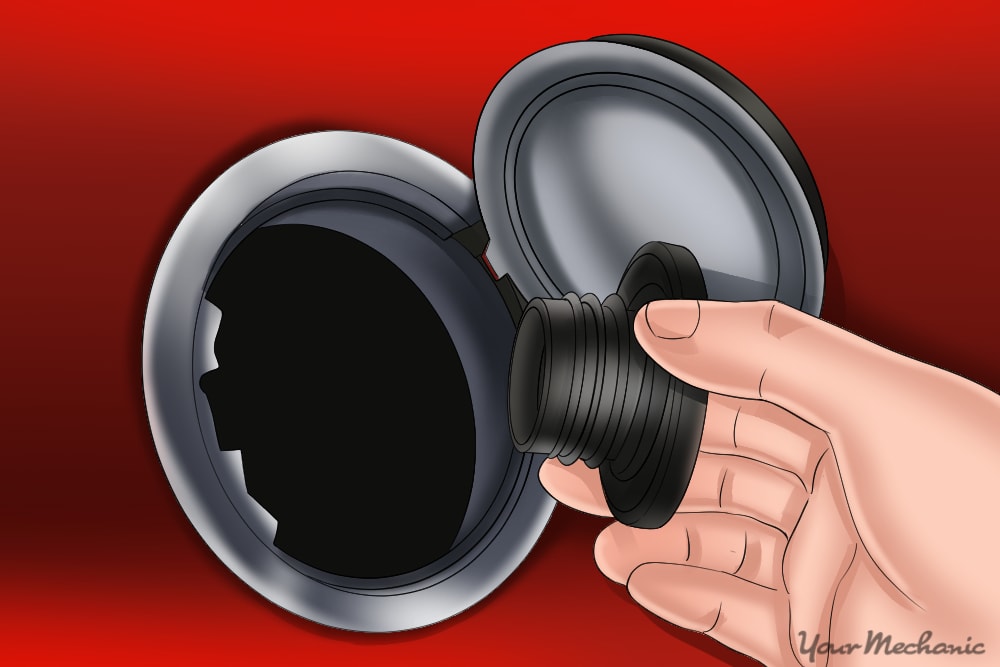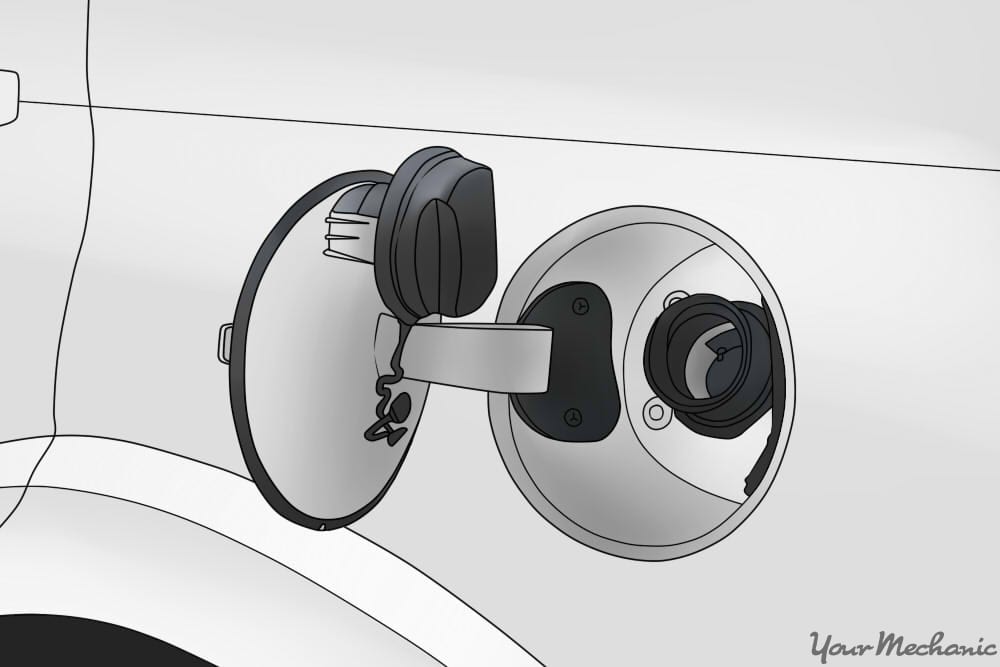

One of the most frustrating situations a car owner may experience is showing up to a gas station with a car with a stuck gas cap cover or fuel door. It always seems that "Murphy" and his "Law" tend to pop up at the most inconvenient moments. Such is the case when it comes to discovering that the fuel door on your vehicle won't open as it's designed.
Whether it's due to an internal spring, lack of lubrication, a bent fuel door or problems with the activator lever of button inside the vehicle, there are a few ways you can troubleshoot what's causing this problem, so that you can contact a local professional mechanic and have the damaged gas cap cover repaired.
Noted below are a few of the most common troubleshooting methods for finding out why that fuel door on your vehicle won't open.
Method 1 of 2: Inspect the fuel door lever or button
On many modern cars, trucks, and SUVs, the fuel door is locked from the outside to prevent unauthorized individuals from opening the fuel door and potentially tampering or stealing the gasoline or diesel fuel that powers your vehicle. The fuel door itself is triggered open by a mechanical lever or a push button switch.
The lever operated fuel door devices is commonly attached to a spring-operated locking mechanism located behind the fuel door. As the level is pulled in an upward direction, a cable attached to the lever and to the spring operated locking device is pulled at the same time. When this occurs, the spring operated lock will "click" the fuel door open, allowing you to put fuel inside the fuel tank.
On a button controlled fuel door trigger, an electronic signal is sent through electrical wires to a solenoid that triggers the locking mechanism to "pop" open the fuel cell. This type of control system sends an electrical signal through a relay, to the fuse box, to the wire that is attached to the solenoid and then the solenoid itself.
Because there are multiple fuel door locking devices and systems that are activated inside the vehicle; there are different steps you'll have to take to troubleshoot what's causing the problem. Noted below are the steps to follow to trace the issues with a mechanical, cable operated fuel door and an electric operated fuel door:
Step 1: Inspect the lever for damage: In many cases, a mechanically-operated fuel door will be unable to open if there is mechanical damage to the handle itself. In many cases, the handle is connected to a cable underneath the floorboard on the driver side. This connection can break if the handle is pulled hard enough.
To inspect this component for damage, follow these guidelines:
Remove the dashboard or floorboard cover where the fuel door lever is located.
Inspect the connection from the lever to the cable. If the connection is broken, you'll have to buy a new lever from the auto parts store or dealership and replace the lever.
Step 2: Trace the wire cable from the lever to the fuel door: If during your initial physical inspection you determine that the lever and connection to the wire is good, you'll need to trace the wire to the fuel door.
It's a good idea to have a second person help you with this exam, as one person will have to pull the lever at the source, while the other inspects the connection on the fuel door for activity of the cable.
Locate the cable connection attached behind the fuel door. In many cases you'll have to remove the cover behind the trunk to access the fuel door cable.
While one person pulls up on the cable, note the action of the cable. If the cable is moving but the door does not click, the problem will be the locking mechanism and not the cable. If the cable does not move, but is secure on the lever, you'll have to remove and replace the cable as its most likely damaged somewhere in between the two connections.
Steps for troubleshooting an electrical operated fuel door:
Most modern cars have an electrically operated fuel door locking mechanism. This type of system uses a button that is usually located on the dashboard, center console or the floorboard that when activated, sends an electrical signal to the locking mechanism behind the fuel door.
There are several components that could cause this system to malfunction, which is why it's always a good idea to defer to the expertise of a professional mechanic to complete this troubleshooting inspection.
However, for purposes of education, a few of the following components may be damaged that cause the fuel door to not active:
- The button or activator inside the vehicle cabin
- The relay switch connected to the locking solenoid
- The fuse that activates the solenoid
- The wires running from the button to the relay
- The locking cylinder
- The electrical solenoid
Once the broken component has been found, it will need to be replaced in order to restore function to the fuel door. If you discover that any of the above issues exists with your fuel door, contact a professional mechanic to repair the fuel door on your vehicle, or purchase and review the exact steps noted in your vehicle's service manual to complete this service independently.
Method 2 of 2: Inspecting the fuel door for damage
If the interior cables, handles, buttons, or electrical components that operate the door are in good shape, the issue of the locked fuel door is most likely contributed to the door itself being damaged or the components that comprise the fuel door and locking mechanism.
To troubleshoot this issue, you're going to have to find a way to open the door itself first. Depending on the type of activation mechanism you have (a cable or electric solenoid), will determine how you can open the door without damaging the door or other components.
Step 1: Try to access the cable that triggers the lock behind the fuel door: If you have a cable operated lock, you might be able to open the door by removing the truck interior on the side where the fuel cell door is located and manually pulling the cable until the door "pops" unlock.
If this method does not work, you may have to contact a professional mechanic to complete his service for you.
Step 2: Find the manual release button behind the fuel door on electrically operated fuel doors: Most domestic and foreign auto manufacturers have a button located on the back of the fuel door (behind the truck interior) that can be pressed manually to unlock the door. The image above shows you the location of this button on most cars.
If you can press this button and the door unlocks, then the damaged is related to an electrical problem.
Step 3: Inspect the two probable suspects: the plunger and pop-open spring: On most electrical operated fuel doors, there are two parts that sometimes fail. The first is the plunger, which is what secures the door to the vehicle when it's locked. This plunger will pull open when the solenoid is activated.
To check the operation of this part, you'll need a second person. Follow these guidelines:
With the fuel door open as the image displays, press the plunger down to "lock" into position. If the plunger does not snap into locking position, this component is damaged and needs to be replaced.
If the plunger does snap locked, have your assistant press the door unlocking button in the vehicle. If the plunger pops out, the issue might be with the door itself or where the plunger connects to the fuel door.
Check the pop-open spring:
Try to move the door open and closed (without locking the fuel door) to inspect the action of the spring. If the spring seems tight or is making a creaking sound, try to apply some WD-40 or penetrating fluid to loosen the spring.
If the pop-open spring appears damaged, this might be causing the door to stay shut and will need to be replaced.
If you've tried all of these troubleshooting steps and still can't determine why the fuel door won't open or lock, contact a professional mechanic, such as one from YourMechanic, to inspect the fuel door and determine what's broken and make appropriate repairs as needed.




